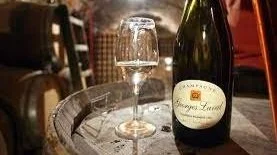Champagne Georges Laval
This tiny, impeccably-run estate in Cumières is known only to a select few connoisseurs of champagne. You could drive through the village a hundred times without knowing it was there, and in fact, aside from a well-worn, barely legible placard with the words “Champagne Georges Laval” written in about three millimeter-high script just above the doorbell, there is no marking whatsoever to indicate its presence. Behind these simple, unassuming wooden doors, however, lies one of Champagne’s great treasures. While the Laval family has been growing vines for four generations, Georges Laval began producing estate-bottled champagne in 1971. His son Vincent joined the estate after finishing his studies in 1991, and has been in charge of the cellars since 1996.
Laval’s vineyard holdings comprise just 2.5 hectares, including a half-hectare of meunier in Chambrecy, in the Vallée de l’Ardre in the western Montagne de Reims. The other two hectares are all in the premier cru village of Cumières, spread over seven parcels. Average vine age is over 30 years, and the oldest vines of the estate are over 70 years of age.The Lavals have been practicing organic viticulture since 1971, certified by Ecocert. “It’s a little more difficult to work organically than conventionally,” says Vincent Laval, “but it can be done, of course, and afterwards you have a better conscience.” He notes that having larger parcels of vines makes it easier to work organically, with less pollution from neighbors, and over the years the Lavals have traded parcels of land whenever possible in order to assemble larger blocks of vines. Organic compost is used, and cover crops are planted in all of the plots, with regular tilling to oxygenate the soil and encourage the roots to descend deeper.In the cellar, the grapes are pressed in a traditional Coquard vertical press that holds a mere 2,000 kilograms—the minimum size allowed in Champagne—in order to ensure maximum quality and control over individual parcels. Laval’s wines are harvested ripe and almost never chaptalized, and fermentation takes place in barrel, with indigenous yeasts. The wines are bottled late, usually about ten months after the harvest, and they are neither fined, filtered nor cold-stabilized. While Laval is not against the use of sulfur, he does try to limit its use as much as possible: sulfur is added at the harvest and then throughout the course of vinification only if strictly necessary. The result is an unusually low level of total sulfur in the finished champagnes, usually below 20 milligrams per liter.
Champagne is full of tiny grower estates that fly under the radar of most wine consumers, but I doubt that any estate so little known as Georges Laval is as remarkably high in quality. The major problem, of course, is quantity, as Laval produces a mere 10,000 bottles in a generous year, and these are quickly and eagerly snapped up by a small, cult-like following of devotees. If you are fortunate enough to be able to procure a bottle of Georges Laval champagne, however, you will be amply rewarded: these are wines of intense personality, highly expressive of both the terroir of Cumières and of Laval’s philosophies of natural winegrowing and winemaking.
The majority of his champagnes are released without dosage, and their ripeness and depth give them a rare harmony, complexity and completeness, emphasizing their vinosity and mineral character. Laval releases his non-vintage champagne as both a brut and a brut nature: the brut usually has between four and five grams of sugar per liter, while the brut nature is, obviously, non-dosé. In the past, Georges Laval used to make this wine with one-third of each variety, but since 1992 the percentage of chardonnay has been increased, and today Vincent Laval’s blends are normally made up of about half chardonnay, although the exact proportions can change according to the base year. In addition, the proportion of reserve wine can vary dramatically: some versions are actually made entirely from a single year, while others can incorporate small amounts of wine from previous years, as Laval sees fit. With Laval’s meticulous selection and attention to detail, this is hardly an ordinary non-vintage brut, often showing a level of expression and complexity that can rival other producers’ vintage champagnes, and it is also a wine that’s well worth keeping in the cellar. (Profile courtesy of Peter Liem’s ChampagneGuide.net)

